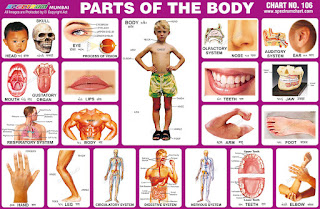Head – A head is the part
of a human body, which comprises the eyes, ears, nose and mouth,
each of which aid in various sensory functions, such as sight,
hearing, smell and taste.
Skull –The human skull is
the bony structure that forms the head in the human skeleton. It
supports the structures of the face and forms a cavity for the
brain.
Mouth – Mouth is an
opening in the face, is the first part of the alimentary canal
(digestive system). It is the place where the chewing of food
occurs. The mouth has teeth to help chew the food.
Gustatory Organ – The
gustatory organ refers to the receptors which initiate the sense of
taste, is found within the taste buds. They are highly specialized
epithelial cells.
Lips – The Lips are a
body part around the mouth. There is a lower lip, and a upper lip.
They help us to eat, touch and speak. Lips also show emotions. The
upper and lower lips are referred to as the "Labium superius
oris" and "Labium inferius oris", respectively.
Eyes – Eyes are the
organs of vision. Eyes detect light and allow us to see. The part of
the eye that allows us to focus on different things in known as the
lens, it changes shapes so we can focus on objects at various
distances.
Respiratory System – The
respiratory system is a biological system consisting of specific
organs and structures used for the process of respiration in a human
body. The respiratory system is involved in the intake and exchange
of oxygen and carbon dioxide.
Chest - Chest is a part of
human body located between the neck and the abdomen. It contains
organs including the heart, lungs and thymus gland, as well as
muscles and various other internal structures.
Stomach – Stomach is part
of the digestive system. The stomach is the third stage in the
digestive process. It holds food after ingestion. Food in the
stomach then passes through to the small intestine where most of the
food's nutrition are absorbed.
Hand – A hand is the part
of the body at the end of an arm. Humans have two hands. Each hand
has four fingers and athumb. On the inside of the hand is the palm.
Among humans, the hands play an important function in body language
and sign language.
Leg – Human leg, is the
entire lower extremity of the human body, including the foot,thigh
and even the hip or gluteal region. Legs are used for standing,
walking, jumping, running, dancing and similar activities and
constitute a significant portion of a person's mass.
Circulatory System – The
circulatory system is an organ system that permits blood to
circulate and transport nutrients, oxygen, carbon dioxide,hormones
and blood cells to and from the cells in the body to provide
nourishment and help in fighting diseases.
Digestive System –
Digestive system consists of organs like tongue, salivary glands,
liver, pancreas and gallbladder. The digestive system is responsible
for breaking down food we eat into smaller components so that
nutrients can be easily absorbed by the body and the waste
discarded.
Nervous System - The
nervous system is a complex structure of nerves of neurons that
transmit signals around the body to coordinate actions. It is in
effect our body's electrical wiring.The Central Nervous System
includes the brain, spinal cord and retina of the eyes.
Teeth – The human teeth
function is mechanically breaking down items of food by cutting and
crushing them in preparation for swallowing and digestion. There are
four different types of teeth, namely incisors, canines, molars and
premolars.
Elbow – Elbow is a
synovial hinge-joint between the bones of the upper and lower arm.
It allows the lower arm to be extended or retracted. The elbow also
allows the arm to turn.
Olfactory System – The
olfactory system is the sensory system used for olfaction or the
sense of smell. The olfactory system is often spoken as being
similar to the gustatory system (taste system). Both are
chemosensory senses.
Nose – A nose is a body
part which allows humans to breathe air & smell things. It
filters the air breathed in, removing dust, germs and irritants. It
warms and moistens the air to keep the lungs and tubes that lead to
them from drying out.
Ear – The ear is the
organ of hearing. Ears convert sound waves into nerve impulses that
are sent to the brain. While your ears pick up the sound, it is your
brain that does the hard work of making sense of it all.
Auditory System – The
auditory system is the sensory system for the sense of hearing. It
includes both the sensory organs (the ears) and the auditory parts
of the sensory system.
Jaw – The jaw is the bone
in the mouth that, in humans, lets the mouth move up and down in
order to chew. It is joined onto to the skull.
Arm – An arm is a limb.
Most humans have two arms each, coming out of their body just below
the neck. On the end of each arm is a hand.
Foot – A foot is a body
part on the end of a leg. We use it when walking, and it is
important for balance, it helps us to stand straight. In a human
foot, there are 26 bones.


No comments:
Post a Comment